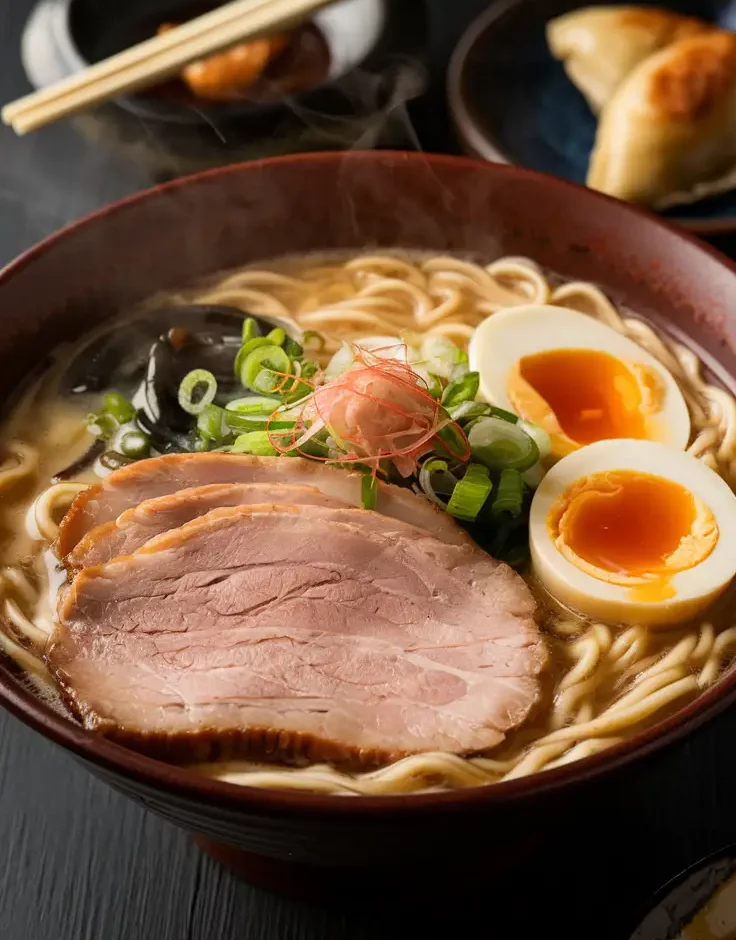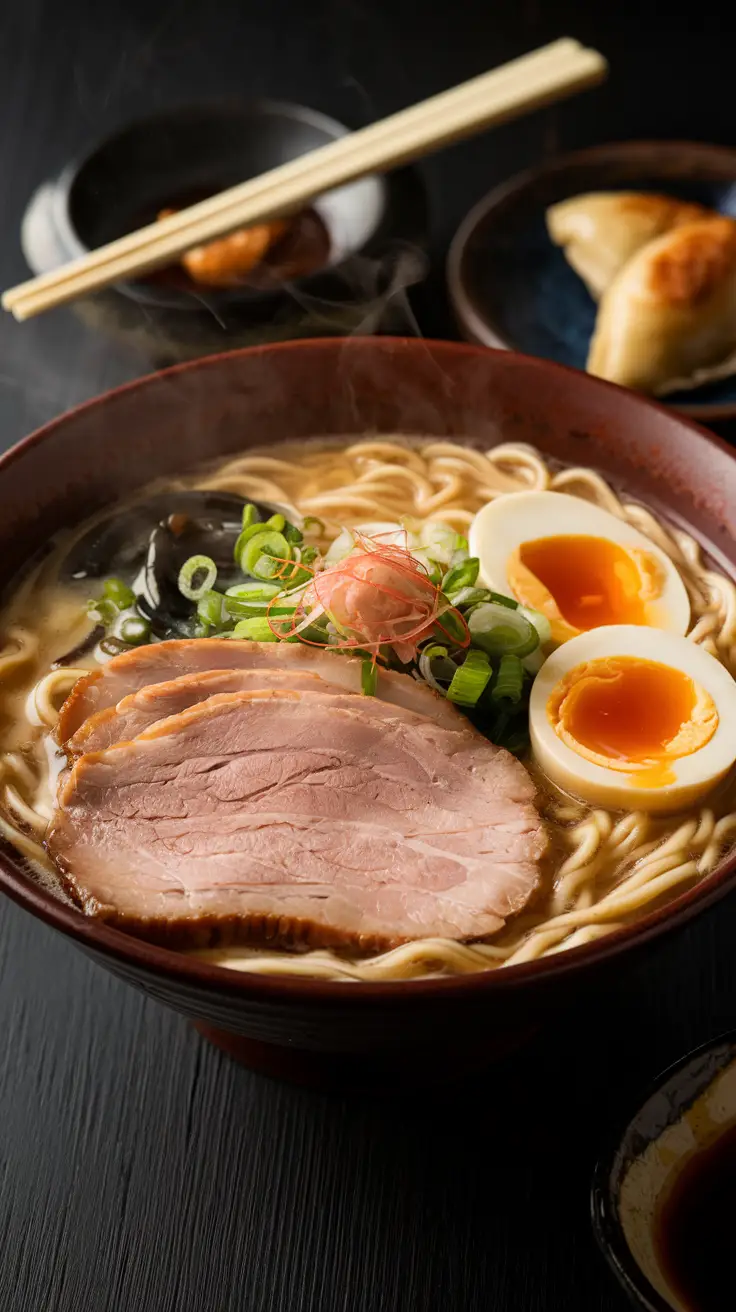
- Start with the eggs
Bring water to boil in a medium pot. Gently lower 4 eggs into boiling water and cook for exactly 6.5 minutes. Transfer immediately to an ice bath, let cool for 5 minutes, then peel carefully and set aside.
- Blanch your pork bones first
In a large stockpot, bring water to a rolling boil. Add the 3 lbs pork bones and 1 lb pork shoulder chunks. Boil vigorously for 5 minutes—you'll see gross foam rising to the surface.
- Drain and rinse everything thoroughly
Pour out the water and rinse bones and pork under cold running water, scrubbing off any remaining impurities with your hands. This step is crucial for clean-tasting broth.
- Return bones and pork to the clean pot
Add the quartered onion (skin and all), 4 smashed garlic cloves, sliced ginger, and roughly chopped green onions. Pour in exactly 12 cups of fresh water.
- Bring to a rolling boil over high heat
Once boiling vigorously, reduce heat to medium-high to maintain a strong simmer. Don't cover completely; leave the lid slightly ajar to prevent overflow.
- Simmer for 3 full hours, stirring occasionally
Every 30 minutes, skim off any foam with a ladle. The broth should stay at a gentle but consistent bubble. Add more hot water if the level drops below the bones.
- Prepare your garnishes during the last 30 minutes
Slice your green onions finely, drain and rinse bamboo shoots, halve your soft-boiled eggs, and have your nori sheets ready.
- Strain the finished broth
Pour everything through a fine-mesh strainer into another large pot. Press the solids gently to extract more liquid, then discard them (save some pork shoulder pieces for Chashu if desired).
- Season the broth with salt to taste
Start with 1 teaspoon and add more gradually. The broth should be well-seasoned but not salty, remember, the toppings add flavor too.
- Cook the ramen noodles in a separate pot
Bring fresh water to boil, add 1.2 lbs fresh noodles, and cook for 2-3 minutes until just tender. Drain immediately and divide among 4 warmed bowls.
- Assemble each bowl systematically
First, ladle hot broth over noodles (about 1.5 cups per bowl). Then arrange toppings: place 2 egg halves, 1 slice Chashu pork, 1/4 cup bamboo shoots, and 2 nori sheet halves around the bowl.
- Finish with fresh garnishes
Sprinkle sliced green onions over each bowl and drizzle with 1/2 tablespoon black garlic oil if using. Serve immediately while piping hot.
- Calories:520 kcals
- Fat:24 grams
- Proteins:28 grams
- Carbohydrates:52 grams
Ever wondered what happens when Japanese ramen gets a southern makeover? Kagoshima Ramen is essentially what happens when Tonkotsu ramen decides to take a vacation to Kyushu and returns with a serious tan and a new attitude. This creamy, pork-bone masterpiece from Japan’s southernmost prefecture is so rich it makes regular ramen look like it’s on a diet.
Why This Kagoshima Ramen Recipe is Awesome
Here’s the thing about Kagoshima Ramen, it’s liquid gold in a bowl, but without the pretentious price tag. Moreover, this recipe transforms your kitchen into a legitimate ramen shop, complete with that amazing aroma that’ll have your neighbors “accidentally” dropping by around dinnertime.
What makes this particularly brilliant is the cloudy, milky broth, which looks intimidating but is surprisingly straightforward to prepare. Furthermore, unlike some ramen styles that require seventeen different specialty ingredients, Kagoshima ramen keeps things relatively simple while delivering maximum flavor impact. Plus, once you get that broth simmering, you’re free to binge-watch Netflix while it works its magic.
Bonus points: This recipe makes enough broth for multiple meals, so you can feel like a ramen wizard all week long. IMO, that’s what we call a win-win situation.
Common Mistakes to Avoid
Don’t skip the blanching step seriously, that initial boil removes all the weird stuff that’ll make your broth taste like feet. stage. You want a gentle simmer, not Mount Vesuvius in your kitchen.
Overcooking the noodles is another classic blunder. They should have some bite left since they’ll continue cooking in the hot broth. Moreover, don’t add salt too early to your broth, wait until it’s finished simmering so you can control the final flavor.
Forgetting to warm your bowls is a rookie mistake that’ll cool down your ramen faster than you can say “itadakimasu.” Run them under hot water or pop them in a low oven for a few minutes.
Finally, don’t try to rush the broth good things come to those who wait, and great ramen comes to those who simmer patiently.
Alternatives & Substitutions
No pork bones? Chicken bones work too, though you’ll get a lighter broth. Use about 4 lbs of chicken bones and simmer for 2 hours instead of 3. The result is different but still delicious.
Vegetarian version? Replace bones with a mix of mushrooms (shiitake, kombu, and miso paste). It won’t be traditional Kagoshima style, but it’ll still warm your soul on a cold day.
Can’t find fresh ramen noodles? Dried ramen works fine, just don’t use the flavor packets. Save those for when you’re broke and desperate (we’ve all been there).
No bamboo shoots? Bean sprouts, corn, or even thinly sliced cabbage work as substitutes. The goal is texture and freshness to balance the rich broth.
Frequently Asked Questions About Kagoshima Ramen
Q: Can I make this in a slow cooker? A: Absolutely! After blanching, throw everything in your slow cooker on low for 8 hours. It’s basically the lazy person’s guide to amazing ramen broth.
Q: How long does the broth keep? A: In the fridge for up to 5 days, or freeze it for up to 3 months. Pro tip: freeze it in ice cube trays for instant ramen upgrades later.
Q: Is this actually how they make it in Kagoshima? A: Look, I’m giving you the home-cook version that won’t require a 12-hour commitment or professional equipment. It’s delicious and authentic enough for your kitchen.
Q: Can I use a pressure cooker? A: Yes! After blanching, pressure cook on high for 90 minutes with natural release. You’ll get similar results in less time.
Q: What’s the deal with black garlic oil? A: It adds a smoky, umami depth that takes the ramen from good to “holy moly.” Make it by slowly heating minced garlic in oil until it turns dark.
Q: My broth isn’t cloudy enough. What went wrong? A: You probably didn’t simmer it vigorously enough at the beginning. Next time, let it boil more aggressively for the first 30 minutes to emulsify those fats.
Q: Can I add vegetables to the broth while cooking? A: Sure, but stick to aromatics like onion, garlic, and ginger. Save the fancy vegetables for garnish, nobody wants mushy carrots floating around.
Final Thoughts
And there you have it, Kagoshima Ramen that’ll transport you straight to southern Japan without the plane ticket or jet lag. This recipe proves that some of the best things in life require a little patience and a lot of simmering.
The beauty of this dish lies in its simplicity disguised as complexity. While the broth takes time, most of that time is hands-off, leaving you free to do whatever you want. Furthermore, once you master this base, you can customize it however your heart desires.
So fire up that stove, embrace the long simmer, and get ready to create something that’ll make your kitchen smell like heaven and your taste buds do a happy dance. Your future self will thank you for taking the time to make real ramen from scratch. Now get cooking, that broth won’t make itself!










